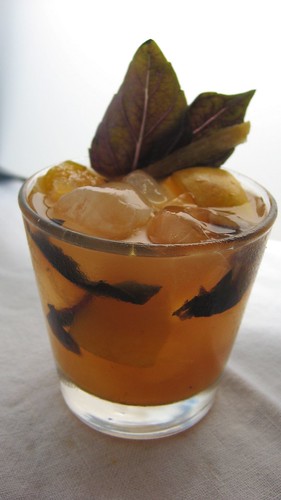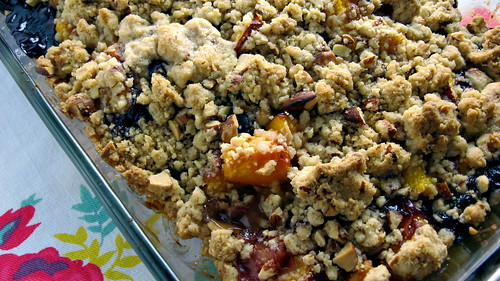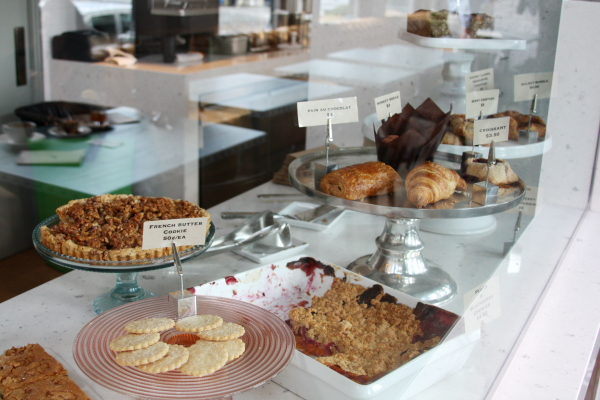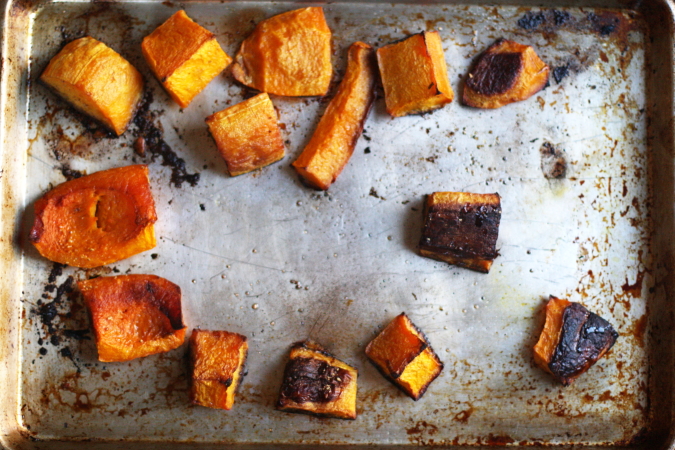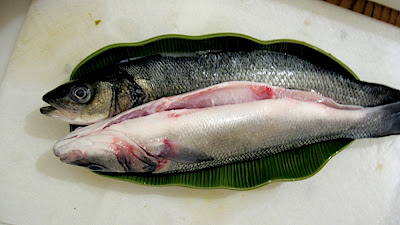
There’s a certain amount of fearlessness required to do anything unfamiliar. Faith helps, especially when facing an impressively difficult task. Steve Martin, the well-known grey haired comedian/writer (“well excuuuuuuuse me!”) says in his recent memoir “Born Standing Up” that naivite is the single most important trait required for anyone about to do something truly difficult. Pure, bright-eyed innocence of what trials are awaiting them is what is needed in order to protect the individual “from knowing just how unsuited [they] are for what [they] are about to do.”
And so it is with prepping, gutting and eating a whole fish.
When it comes to cooking, you have to be a little fearless, a touch naïve, and full of faith that your efforts will result in something good—and hopefully—something really delicious. There’s only so much research you can do. Not every task has a clear set of rules. Sometimes you just have to wing it.
Which is exactly what I did last week when I went to the market and was dazzled by the beautiful, clear-eyed whole fish on display. I never hesitated selecting a pound of whole sardines and two glorious, whole branzino from the shaved ice. It didn’t matter I had never cleaned a fish myself. I had faith that I could figure it out.
In all my years of working in restaurants, I’ve seen hundreds of fish scaled, cleaned and filleted. I’ve watched cooks throw whole fish onto their cutting boards and deftly use their knives to slice through the skin to reveal the tangerine flesh of salmon and the milky white meat of snapper. I’ve noticed how the back of a knife could be used to peel scales from the delicate skin of the fish. I’ve heard the percussive thud of fish head after fish head, hitting the side of the rubber garbage bin. So when I got home with my fish I figured just how hard could cleaning a fish be?
Back home in the kitchen, I immediately went to work. I washed my hands, ripped open the fishmonger’s paper packages and admired my bounty. The fishes’ tiny eyes shone bright and their silvery scales glistened in the kitchen light. I marveled at their fresh, clean smell. When I was good and ready to say goodbye to the pristine natural state of the fish, I took out my Knife Skills book and scanned its pages for tips on gutting.
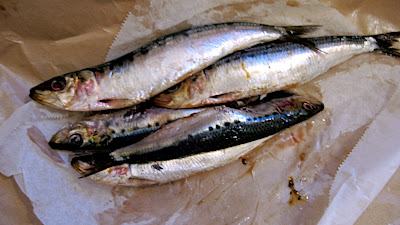
Plenty of information is to be had on how to fillet (the left handed and right handed versions are beautifully illustrated), but to my surprise, Knife Skills doesn’t see the need to mention the fish gutting step. Feeling up to the challenge, I took my one good chef’s knife and pointed its tip into the belly of the first sardine. The knife barely pierced the fish’s delicate flesh, indicating that I had learned my first valuable lesson in gutting a fish.
1) Sharpen your knife.
After a good once over with my knife sharpener, I was ready to slice into the belly of the sardine. It was simple enough, running the knife along the belly to reveal the center cavity. Inside, the contents were easy enough to remove with the gentle swipe of a finger.
Gutting the whole branzino (whole black bass), however, offered to be a tad more difficult. The branzino, though much more hearty and therefore easier to work with (i.e. was more forgiving to my novice gutting skills), required scaling. Going from memory, I used the back of my knife to lightly push the scales back and off the fish. As I washed the skin under the sink’s cold water, I felt the skin with my fingers to find what spots I missed.
When it came time to gut the fish, self-doubt began to creep in. My husband is a perceptive man (and also a fifteen year restaurant professional) and took the opportune moment to give me some sage words of advice gleaned from a former employer, Michael Cimarusti, the well known chef/owner of the sea-food driven restaurant Providence. “Michael used to say that gutting a fish is easy” Hans told me in practically a whisper. “The fish’s meat stays firm and while the rest just slides away.”
I took a deep breath, let my sharpened knife slide through the thin layer of skin. Once inside the internal cavity, the organs did just as Cimarusti said they would. The liver, stomach and kidneys slipped onto the cutting board without a struggle. I rinsed the cavity to make sure I had removed everything and nothing unnecessary remained.
2) Let the fish release its insides to you
Following a very simple recipe from Mario Batali’s Molto Mario cookbook, I lightly seasoned the inside and outside of the fish, drizzled it in olive oil, and cooked it for three minutes on each side under the broiler for a total of 12 minutes. When done, the meat is moist, sweet and unbelievably delicious.
Of course, the real adventure of preparing a whole fish begins when you eat it. There are no rules. Whole fish, like lobster, is an incredibly rustic meal that appeals to meat foragers and people who aren’t afraid to get a little messy at the dinner table. Fingers are good instruments to find the bones, but depending on your dining environment, eating with your hands isn’t always possible. Regardless, care must be taken when eating a whole fish. Remove as many bones as you can–in one grand, head to tail gesture is always fun—but be sure not to throw away the head! The cheeks are one of the most delicious parts of the fish!

Mario Batali’s recipe for Branzino alla Griglia:
Grilled whole black bass with onions, olives and red chard
Makes 4 servings
Two 2-pound black bass (branzino), cleaned and scaled
¼ cup plus 2 tablespoons Extra Virgin Olive Oil
1 large red onion, thinly sliced
1 cup Ligurian black olives. I used one jar of Mediterranean olives from Whole Foods
2 pounds red Swiss chard, *trimmed and cut into 1-inch wide ribbons.
Grated zest and juice of one lemon
Salt and freshly ground black pepper
½ cup olive paste
2 lemonds cut into 6 wedges (for serving)
*trim the leaves of the internal stalk of the chard but make sure to save these pieces for the recipe! To create 1 inch wide ribbons, roll the trimmed leaves up like a cigar and cut horizontally against the rolled up greens.
Preheat grill or broiler. Heat a 12-inch sauté pan over medium heat, and add ¼ cup of the olive oil. Add the onion and cook until wilted, about 2 minutes. Add the olives, chard, lemon zest and the juice. Toss until the chard is wilted, about 3 minutes. Season to taste with salt and pepper. Remove from heat and cover to keep warm.
Season the fish inside and out with salt and pepper. Brush with the remaining 2 tablespoons of olive oil. Place on grill or on a cooking sheet under the broiler for 3 minutes on each side, for a total of 12 to 15 minutes. Cook until cooked through yet still moist.
Just before serving, reheat the chard (if necessary). Place the
fish on a large serving platter, arrange the chard around the border, and serve immediately with the olive paste and lemon wedges along side.
